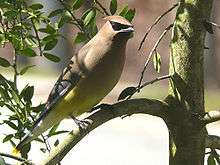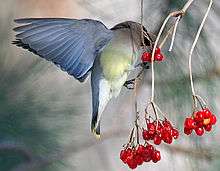Cedar waxwing
| Cedar waxwing | |
|---|---|
 | |
| Cedar Waxwing in Pennsylvania, USA | |
| | |
| Song | |
| Scientific classification | |
| Kingdom: | Animalia |
| Phylum: | Chordata |
| Class: | Aves |
| Order: | Passeriformes |
| Family: | Bombycillidae |
| Genus: | Bombycilla |
| Species: | B. cedrorum |
| Binomial name | |
| Bombycilla cedrorum Vieillot, 1808 | |
 | |
| Cedar waxwing range Breeding range Year-round range Wintering range | |
| Synonyms | |
|
Ampelis cedrorum | |
The cedar waxwing (Bombycilla cedrorum) is a member of the family Bombycillidae or waxwing family of passerine birds. It is a medium-sized, mostly brown, gray, and yellow bird named for its wax-like wing tips. It is a native of North and Central America, breeding in open wooded areas in southern Canada and wintering in the southern half of the United States, Central America, and the far northwest of South America. Its diet includes cedar cones, fruit, and insects.[2] The cedar waxwing is not endangered.
The genus name Bombycilla comes from the Ancient Greek bombux, "silk" and the Modern Latin cilla, "tail";[3] this is a direct translation of the German Seidenschwanz, "silk-tail", and refers to the silky-soft plumage of these birds.[4] The specific cedrorum is Latin for "of the cedars".[3]
Description

Cedar waxwings are a medium-sized bird approximately 6–7 in (15–18 cm) long and weigh roughly 30 g (1.1 oz). They are smaller and more brown than their close relative, the Bohemian waxwing (which breeds farther to the north and west). It is a "silky, shiny collection of brown, gray, and lemon-yellow, accented with a subdued crest, rakish black mask, and brilliant-red wax droplets on the wing feathers."[5] These droplets may be the same color as the madrone berries they are known to eat.[6] These birds' most prominent feature is this small cluster of red wax-like droplets on tips of secondary flight feathers on the wings, a feature they share with the Bohemian waxwing (but not the Japanese waxwing). The wings are "broad and pointed, like a starling's."[5] The tail is typically yellow or orange depending on diet. Birds that have fed on berries of introduced Eurasian honeysuckles while growing tail feathers will have darker orange-tipped tail-feathers.[7] The tail is somewhat short, and square-tipped.[5] Adults have a pale yellow belly. The waxwing's crest often "lies flat and droops over the back of the head."[5] It has a short and wide bill.[5] The waxwing's black mask has a thin white border. Immature birds are streaked on the throat and flanks, and often do not have the black mask of the adults. Males and females look alike.[8]
The flight of waxwings is strong and direct, and the movement of the flock in flight resembles that of a flock of small pale European starlings. Cedar waxwings fly at 40 km/h (25 mph) and fly at an altitude of 610 m (2,000 ft).
Cedar waxwings are also known as the southern waxwing, Canada robin, cedar bird, cherry bird, or recellet.
The oldest observed cedar waxwing was eight years and two months old.[7]
Vocalizations
The two common calls of these birds include very high-pitched whistles and buzzy trills about a half second long often represented as see or sree.[7][9] Its call can also be described as "high, thin, whistles."[5] They call often, especially in flight.[7]
Distribution and habitat

Preferred habitat consists of trees at the edge of wooded areas, or "open" forests, especially those that provide access to berry sources as well as water. They are frequently seen in fruiting trees.[5] Waxwings are attracted to the sound of running water, and love to bathe in and drink from shallow creeks. In urban or suburban environments, waxwings often favor parkland with well-spaced trees; golf courses, cemeteries, or other landscaping with well-spaced trees; bushes that provide berries; and a nearby water source such as a fountain or birdbath. Also look for them near farms, orchards, and gardens, particularly ones with fruiting trees or shrubs.[5]
Outside the breeding season, cedar waxwings often feed in large flocks numbering hundreds of birds. This species is nomadic and irruptive,[10] with erratic winter movements, though most of the population migrates farther south into the United States and beyond, sometimes reaching as far as northern South America. They will move in huge numbers if berry supplies are low. Rare vagrants have reached western Europe, and there are two recorded occurrences of cedar waxwing sightings in Great Britain. Individual Bohemian Waxwings will occasionally join large winter flocks of cedar waxwings.
Behavior and ecology
Cedar waxwings are sociable, seen in flocks year round.[5] They are non-territorial birds and "will often groom each other."[8] They move from place to place depending on where they can find good sources of berries.[8]
Breeding
Mating season for this bird begins around the end of spring and runs through late summer.[8] The male will do a "hopping dance" for the female. If she is interested, she'll hop back.[8] During courtship the male and female will sit together and pass small objects back and forth, such as flower petals or an insect. Mating pairs will sometimes rub their beaks together affectionately. The nest is a loose open cup built with grass and twigs, lined with softer materials and supported by a tree branch averaging 2 to 6 m (6.6 to 19.7 ft) above ground but, at times, considerably higher. It takes around five or six days for the female waxwing to build the nest and can take up to 2,500 trips back and forth. Sometimes the female will steal nest material from other species' nests to save time.[7] The outer diameter of the nest is approximately 12 to 16 cm (4.7 to 6.3 in). Usually 5 or 6 eggs are laid and the female incubates them for 11 to 13 days.[7] The eggs are oval shaped with a smooth surface and very little, if any, gloss. The egg shells are of various shades of light or bluish grey with irregular, dark brown spots or greyish-brown splotches.[7] Both parents build the nest and feed the young. Typically, there are one or two broods during the mating season.[7] Young leave the nest about 14 to 18 days after hatching.[7]
Diet



The cedar waxwing eats berries and sugary fruit year-round, including "dogwood, serviceberry, cedar, juniper, hawthorn, and winterberry",[5] with insects becoming an important part of the diet in the breeding season. Its fondness for the small cones of the eastern redcedar (a kind of juniper) gave this bird its common name. They eat berries whole.[5] They sometimes fly over water to catch insects.[5]
When the end of a twig holds a supply of berries that only one bird at a time can reach, members of a flock may line up along the twig and pass berries beak to beak down the line so that each bird gets a chance to eat.[11]
Sometimes, cedar waxwings will eat fruit that is overripe and has begun to ferment, intoxicating the bird.[7]
Conservation status
Waxwings are evaluated as Least Concern on the IUCN Red List of Endangered Species.[1] Populations are increasing in their range partly because fields are being allowed to grow into forests and shrublands, and fruiting trees like mountain ash are being planted as landscaping.[7] On the other hand, cedar waxwings do sometimes crash into windows, and get hit by cars while foraging along roadsides.[7]
References
- 1 2 BirdLife International (2012). "Bombycilla cedrorum". IUCN Red List of Threatened Species. Version 2013.2. International Union for Conservation of Nature. Retrieved 26 November 2013.
- ↑ Tekiela, Stan. Birds of Minnesota Field Guide. Cambridge, MN: Adventure Publications, Inc., 2004. Book.
- 1 2 Jobling, James A (2010). The Helm Dictionary of Scientific Bird Names. London: Christopher Helm. pp. 74, 96. ISBN 978-1-4081-2501-4.
- ↑ Holloway, Joel Ellis (2003). Dictionary of Birds of the United States: Scientific and Common Names. Portland, Oregon: Timber Press. p. 39. ISBN 0-88192-600-0.
- 1 2 3 4 5 6 7 8 9 10 11 12 "All About Birds." Cedar Waxwing, Identification. Cornell Lab of Ornithology, n.d. Web. 24 June 2013.
- ↑ Gurung, Janita; Adams, A.B.; Raphael, Martin G. "A Review of the Use of Pacific Madrone by Nesting, Pollinating and Frugivorous Birds -" (PDF). Retrieved 24 October 2016.
- 1 2 3 4 5 6 7 8 9 10 11 12 "All About Birds." Cedar Waxwing, Life History. Cornell Lab of Ornithology., n.d. Web. 24 June 2013.
- 1 2 3 4 5 "Cedar Waxwing - Bombycilla Cedrorum." Cedar Waxwing. Nature Works, n.d. Web. 15 July 2013. .
- ↑ "American Robin, Kingbirds, Bluebirds and Chickadees of North America." Backyard Birding. n.p, n.d. Web. 18 June 2013.
- ↑ "Cedar Waxwing" BirdWeb. Seattle Audubon Society, n.d. Web. 16 July 2013.
- ↑ Rice, Robert. "Cedar Waxwing." Cedar Waxwing The Movable Feaster. Smithsonian National Zoological Park, May 1997. Web. 11 July 2013.
External links
| Wikimedia Commons has media related to the cedar waxwing. |
| Wikispecies has information related to: Bombycilla cedrorum |
- Cedar Waxwing - Bombycilla cedrorum - USGS Patuxent Bird Identification InfoCenter
- General info, including photos and videos, with specific sites for finding cedar waxwings in San Diego County, California
- Stamps at bird-stamps.org
- "Cedar waxwing media". Internet Bird Collection.
- Cedar waxwing photo gallery at VIREO (Drexel University)
